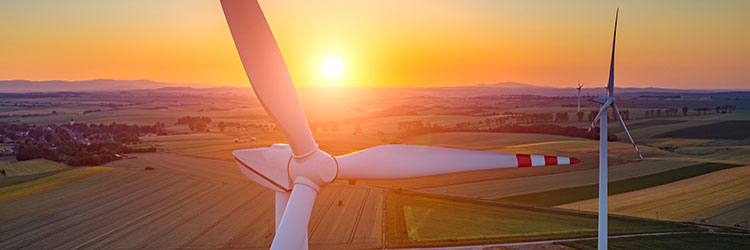Many of us see wind towers every day. Globally, they are becoming an increasingly important source of electricity. In fact, according to the American Wind Energy Association, there has been a $143 billion investment in new wind projects over the past ten years. What many people don’t realize is that behind every wind tower is a comprehensive inspection program during both the manufacturing process and while the tower is in service, to help ensure that each wind tower works properly and is safe. Not inspecting wind towers can lead to dramatic failures that can require the entire structure to be replaced. With so many new wind towers coming online every year, inspection programs have evolved to meet the needs of the industry.
There are three major wind tower components that are routinely inspected during manufacturing and after installation using nondestructive testing technology: the blades, the gearbox, and the tower structure. Each component is critical to the overall productivity and useful life of the wind tower. To inspect such a diverse array of components, companies rely on a suite of complimentary nondestructive testing technologies to get the job done.
Manufacturing
Inspecting components during manufacturing is essential for quality control. If a part fails prematurely, it can add significant cost to a wind tower project. Some manufacturers warranty components, such as gearboxes, so each part that fails during the warranty period potentially costs the manufacturer. Consequently, most manufacturers use nondestructive testing technology, such as remote visual inspection with videoscopes and conventional and phased array ultrasonic flaw detectors, to help ensure that their products meet internal quality standards.
Blades: The blades are made of composites to make them as lightweight as possible. Because the blades are expensive to change out once they’re installed, manufacturers inspect for cracks in the bonding resin and delamination of the composite material inside the blade, and cracking and delamination on the outside of the blade.
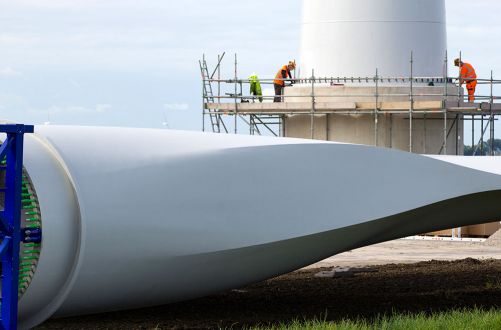 |
| A wind turbine blade waiting to be installed. |
Gearboxes: Gearboxes are very complex. During manufacturing, if components are misaligned or improperly packaged, this can shorten the life of the component. Inspectors pull gearboxes off the assembly line to be inspected for quality control. Remote visual inspection using videoscopes enables inspectors to view inside of the assembled gearbox to confirm that components are working properly.
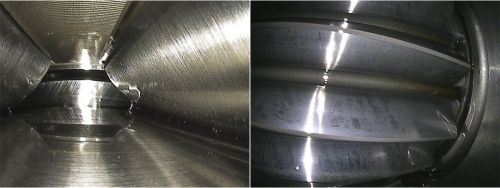 |
| Through-scope images from an IPLEX NX videoscope of the inside of a wind turbine gearbox. |
Tower structures: Wind tower sections are typically constructed by rolling a flat metal plate into a cylinder and then welding the seam. These individual sections are then welded together into pieces small enough to be transported and connected in the field via flanges. It’s especially important for manufacturers to check the quality of these welds to help ensure the integrity of the tower. Common problems include lack of fusion and porosity.
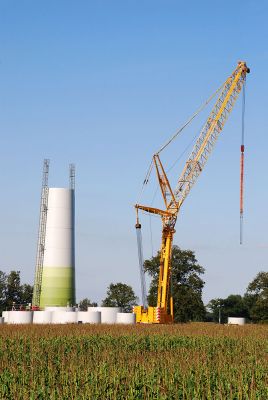 |
| Building a new wind tower. |
In-Service Inspection
Once a wind tower is installed, its various components are exposed to environmental stresses. The entire structure is subject to dynamic loading from the wind as well as other environmental factors, such as moisture, temperature changes, impacts, and lightning strikes.
Failures can be catastrophic and result in the loss of the entire tower. For example, if the gearbox fails, heat generated by the gears could potentially cause the lubricating oil to catch fire. In this instance, hot oil can get sprayed on the blades and tower structure, resulting in a total loss of the wind tower.
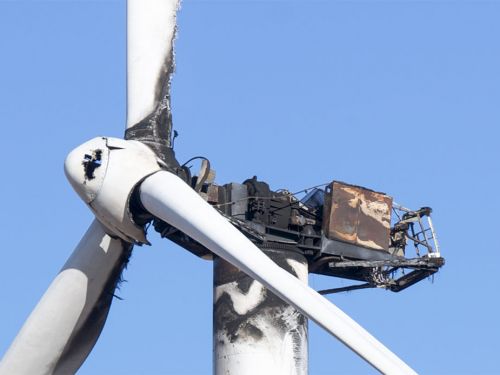 |
| Some wind tower failures, such as a gearbox’s lubricating oil catching fire, can result in the loss of the entire tower. |
One of the obvious challenges of inspecting wind towers is their location. Towers can be taller than 200 feet, and inspecting the blade and tower structure requires the use of ropes and harnesses. Some towers have a winch to bring tools up, but few have any kind of elevator, meaning inspectors need to climb up a ladder to reach the inspection location. Having equipment that is portable, ergonomic, rugged, and powerful is essential to completing the inspection efficiently and safely.
Blades: The force of the wind subjects blades to near constant dynamic loads, putting stress on the blade structure, especially the edge, hub, and tip. Inspectors use a combination of tools to look for damage, disbonds, and delamination in the composite. Conventional ultrasonic technology is used to evaluate damage from lightning strikes so that inspectors know when repairs are required. To evaluate the integrity of the blade’s composite material, inspectors use bond testing instruments that use sound waves to quickly and accurately detect disbonds and delamination. In addition, most blades have small holes so videoscopes can access the inside of the blade. With videoscopes up to 30 m in length, inspectors can visually assess difficult-to-access areas to look for damage.
Gearboxes: Because gearboxes are complex and have many moving parts, they can potentially fail. Videoscopes are ideal tools for inspecting gearboxes; the small insertion tube can easily maneuver inside the box. Portable and durable, the IPLEX® RX/RT videoscope has features designed to address the challenges gearbox inspectors face. One challenge is getting lubricating oil on the lens of the videoscope and blurring the image. The videoscope’s oil clearing scope tip adaptor uses capillary action to draw the oil away from the lens for clearer images and faster inspections. The videoscope’s clear, bright images enable inspectors to check gears for cracking and chipping and inspect the bearings for scratches, pitting, dents, and any other imperfections.
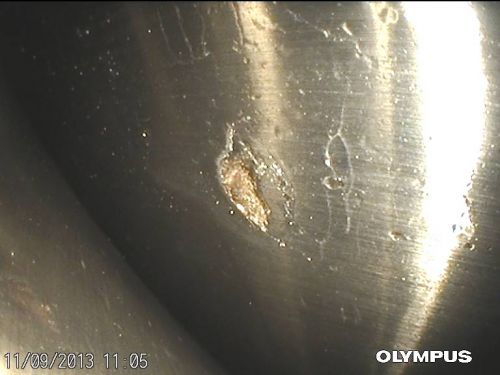 |
| Videoscope image showing a defect on a wind turbine bearing. |
Tower Structures: The force of the wind puts stress on the welded tower segments. Fatigue cracks can eventually lead to tower failure if they’re not identified and repaired in time. Phased array inspection technology, such as in our OmniScan® flaw detector, is used to quickly detect corrosion and cracking in the tower structures. A complementary technology, eddy current array (ECA), is also used to inspect the welds. One of the advantages of ECA over conventional weld inspection techniques is that it works through painted surfaces. While other inspection methods require the welds to be stripped of paint, exposing them to the elements and potentially more corrosion, ECA provides accurate results quickly and easily.
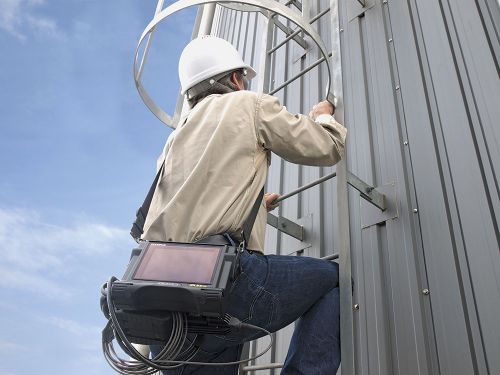 |
| The highly portable IPLEX RX videoscope. |
As the power generation industry continues to change and new technological advancements come online, nondestructive testing technology will continue to adjust to keep pace. Wind towers are an increasingly important source of power all over the world, and nondestructive testing and remote visual inspection technologies play an important role in manufacturing and maintenance. Whether it’s momentary or permanent downtime, the importance of routinely inspecting wind towers is clear.
Check out these other wind power resources
Olympus Wind Turbine Inspection Solutions
Using Videoscopes to Inspect Bearings in a Wind Power Generator
Shear Web Bonding Inspection Solution for Wind Turbine Blades

